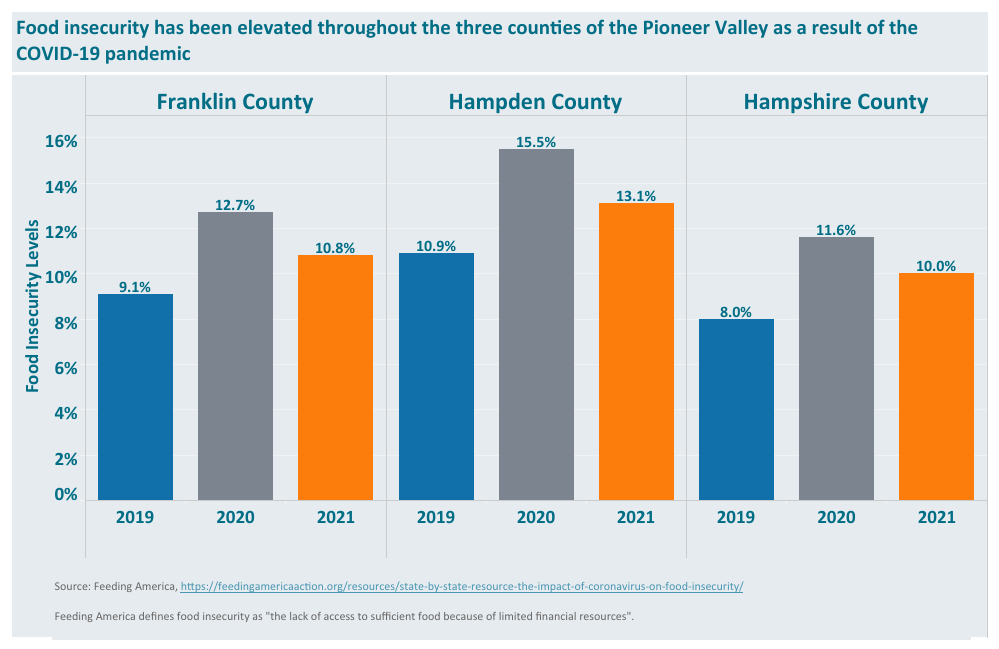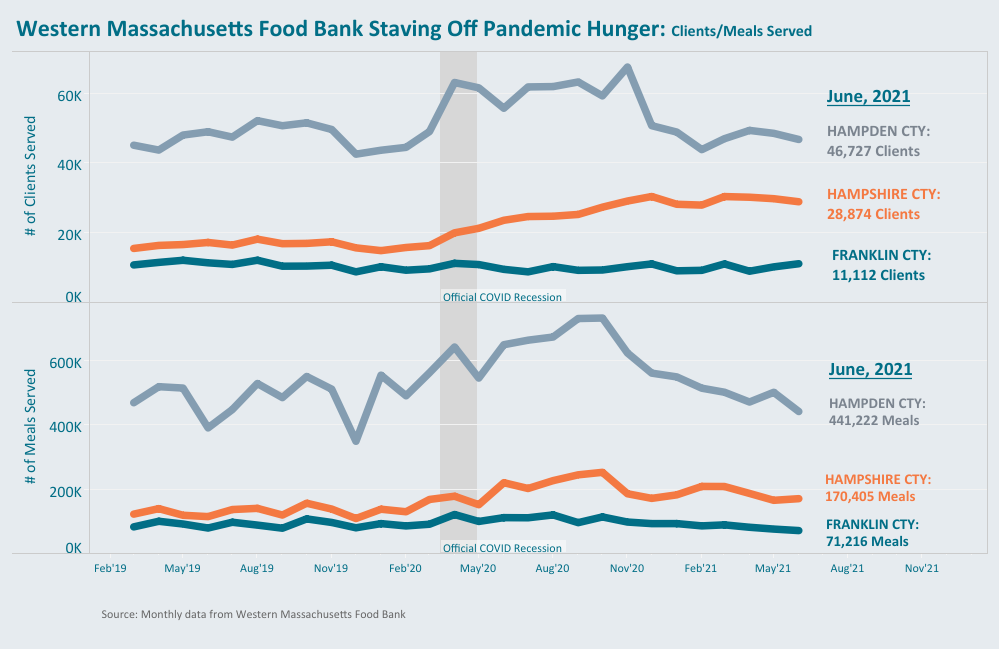COVID Recovery Dashboard, “Safety Net, Food, and Hunger in the Pioneer Valley” Highlights Persistence of Food Insecurity
Pioneer Valley Data's second COVID Recovery Dashboard, “Safety Net, Food, & Hunger in the Pioneer Valley”, highlights disturbing increases in food insecurity throughout the Pioneer Valley during the COVID-19 pandemic. Following the surge in unemployment documented in our first COVID recovery dashboard, “How has the COVID-19 Pandemic Impacted Workers in the Pioneer Valley?”, thousands of families in Franklin, Hampshire, and Hampden Counties have been struggling financially, often facing periods of food insecurity or other material hardships.
Feeding America, a national non-profit agency working to end hunger in the United States, estimates that each of the three counties of the Pioneer Valley saw substantial increases in food insecurity in 2020, growing 40% in Franklin County, 45% in Hampshire County, and 42% in Hampden County. Food insecurity levels have remained elevated in 2021.
In response to this unprecedented spike in need, the many strands of the regional safety net have come together to help Pioneer Valley families weather the economic challenges that have accompanied the COVID-19 pandemic. Two of the most significant strands of support have been programs operated through the Massachusetts Department of Transitional Assistance (especially the Supplemental Nutritional Assistance Program (SNAP, formerly Food Stamps), and food distributed throughout the region by the Food Bank of Western Massachusetts.
The Commonwealth of Massachusetts’ Department of Transitional Assistance (DTA) administers programs funded by both the state and federal governments to help families through challenging times. During the COVID-19 pandemic, several programs were expanded, either by increasing the payment levels, altering the qualifications so more people could receive assistance, or by adding temporary pandemic program expansions, such as the Pandemic Electronic Benefit Transfers (P-EBT) for the SNAP program (formerly known as Food Stamps).
 Across the three counties of the Pioneer Valley, SNAP enrollment increased substantially during the initial weeks of the COVID-19 pandemic, including growth of 32% in Franklin County, 24% in Hampshire County, and 16.4% in Hampden County. Two other programs administered by DTA, the TAFDC (Temporary Assistance for Families with Dependent Children) and the EAEDC (Emergency Aid to the Elderly, Disabled, and Children) saw similar spikes in program enrollment. Unlike the other two programs, SNAP enrollment remains substantially higher than pre-COVID, reflecting ongoing economic hardships facing families in the Pioneer Valley.
Across the three counties of the Pioneer Valley, SNAP enrollment increased substantially during the initial weeks of the COVID-19 pandemic, including growth of 32% in Franklin County, 24% in Hampshire County, and 16.4% in Hampden County. Two other programs administered by DTA, the TAFDC (Temporary Assistance for Families with Dependent Children) and the EAEDC (Emergency Aid to the Elderly, Disabled, and Children) saw similar spikes in program enrollment. Unlike the other two programs, SNAP enrollment remains substantially higher than pre-COVID, reflecting ongoing economic hardships facing families in the Pioneer Valley.
Each month during the COVID-19 pandemic, families struggling with food insecurity turned to local food banks to help feed themselves. Across the three counties in the Pioneer Valley, tens of thousands of families have relied on food from food banks to help them feed themselves. The Food Bank of Western Massachusetts distributes meals in several cities and towns in the Pioneer Valley. Since March 2020, each month they have provided, on average, 877,000 meals to 91,000 clients, peaking at 1.1M meals provided in October, 2020.
Faced with growing unemployment and food insecurity caused by the COVID-19 pandemic, Pioneer Valley residents have been able to turn to the regional non-profit community and to critical government programs to help them meet their basic needs. While we have likely weathered the worst of the COVID-19 pandemic recession, the persistence of food insecurity suggests we need to reinforce our public safety nets to prevent ongoing hunger in the Pioneer Valley. (One such step, closing the so-called "SNAP Gap", would result in an additional 78,000 residents of the Pioneer Valley (people currently eligible, but not enrolled) receiving SNAP benefits.)
______________________________________________________
More detailed data tracking the impact of the COVID-19 pandemic on the people and economy of the Pioneer Valley can be found at https://pioneervalleydata.org/covid-19-recovery.
______________________________________________________
On Wednesday, December, 7, 2021, the Pioneer Valley Planning Commission hosted a community forum, "A Virtual Conversation About Food Insecurity in the Valley" to discuss the issues addressed in this blog post. A recording of that forum is available here.
